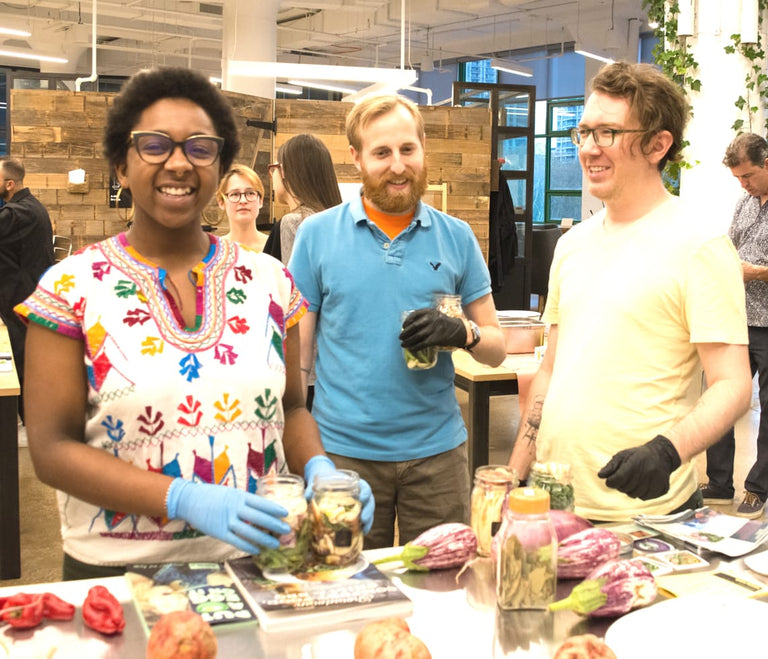Radishes: The Long-Awaited Answer to Our Crunchy Cravings
Article, Photos, and Recipes by Local Roots Volunteer Jess Santoro (@jess_santoro)

Food science has come a long way since we once believed that an apple a day keeps the doctor away. Now, large corporations like Frito-Lay have dedicated entire teams of researchers to the science of one of our favorite food sensations—crunch. Noisy foods remind us of freshness, according to food scientists, though any fiend for potato chips can tell you this can be a mere trick of the mind when we resort to nitrogen-packed chip bags.
For those of us who don’t wish to subsist on potato chips alone, we turn to other crunchy foods to satisfy our cravings. Foods like carrots, celery, and nuts have long since fulfilled our desires for crisp crunches, but have been somewhat overplayed, gracing get-togethers in the form of vegetable platters with ranch and trail mixes so much so that we’ve grown sick of them. So, where do we turn now? That’s right—radishes.
These root vegetables come in a multitude of varieties with adorable nicknames like April Cross, Bunny Tail, and Cherry Belle. Some varieties, like Plum Purple are known to stay crisp longer than the average radish, while others are known for their color variances, like Snow Belle and Watermelon Radishes. Both French Breakfast and Sicily Giant boast unique shapes and sizes from elongated to stout. Across the board, radishes are easy to grow, easy to harvest, and even easier to love.
Expectedly so, flavor profiles differ between varieties, most notably in variations like Sakurajima radishes that offer a distinctly hot flavor and an assortment of Korean radishes that are known for being stronger and sturdier than their cousins. Local Roots varieties like Black Radishes pack powerful flavor and are perfect when grated into a springy slaw in lieu of horseradish. Watermelon Radishes, to be sure the most gorgeous variety, are mild in flavor, but bring brightness with their circular striations of pinkish hues.
Raw radishes provide us with low caloric counts (about 16 calories per 100 grams) and moderate amounts of vitamin C. Beyond this, they possess anticancer properties (Linus Pauling Institute), aid in digestion, and offer small amounts of potassium, vitamin B-6, and vitamin K. Their bulbs are by far the most commonly consumed part of the plant, but their tops can be used for sauces, pestos, and almost anywhere else you’d use a peppery leafy green.
Even though the most commonly known characteristics of these root vegetables is perhaps their crispness and high water content, their peppery taste makes them a flavorful, textured additive perfect to top salads or stand out as the shining ingredients in recipes like the ones featured here:
Garlicky Roasted Radishes
Raw radishes have seen their time in the limelight of culinary appreciation, making welcomed appearances in salads, as garnishes, and seemingly anywhere a bright crispness can be desired. Cooked radishes, on the other hand, have yet to receive such acclaim. While we’re stuck wondering why the heck not, take this social distancing period as an opportunity to try radishes in all their forms. These garlicky roasted radishes act similarly to roasted carrots, packing crunch despite their being cooked, bringing forth a flavor of herby, garlicky goodness all the while. Pro tip: adding the garlic a little more than halfway through the cooking process ensures it won’t burn and will remain pleasantly pungent. This recipe is a quick and easy side that makes for great leftovers whether it’s just reheated, tossed over a leafy salad, or eaten cold right out of the tupperware.
Ingredients:
1 lb. mixed Local Roots radishes, chopped into quarters
1 lb. baby carrots, chopped into 1” pieces
3 garlic cloves, minced
1 tsp. thyme, chopped
2 Tbsp. extra-virgin olive oil
Kosher salt
Freshly ground pepper
Directions:
Preheat oven to 400 degrees. Place radishes and carrots in a medium sized bowl and toss with extra-virgin olive oil, kosher salt, and freshly ground pepper. Roast vegetables for 20-25 minutes, stirring mixture every five to ten minutes to ensure all surface areas are exposed to heat, allowing vegetables to cook evenly. After about fifteen minutes, remove mixture from the oven and add garlic, mixing to coat. Return to oven. When both radishes and carrots can be easily pierced with a fork, remove mixture and let cool before serving.
Article and Recipe by Local Roots Volunteer Jess Santoro (@jess_santoro)
Rather have a taste first?
Local Roots Experiences are fun, pop-up events where we bring the farm to you!

Become a Harvest Club Pick Up Location
Are you a NY based cafe, bar, or neighborhood business? Become a Harvest Club pick up location and have community members come to your establishment each week to pick up their Local Roots harvest.
Top







